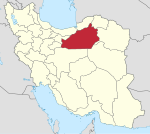Bastam
Bastam
بسطام | |
|---|---|
City | |
 Bayazid Shrine Complex | |
 Bastam | |
| Coordinates: 36°29′07″N 54°59′59″E / 36.48528°N 54.99972°ECoordinates: 36°29′07″N 54°59′59″E / 36.48528°N 54.99972°E | |
| Country | |
| Province | Semnan |
| County | Shahrud |
| Bakhsh | Bastam District |
| Elevation | 1,450 m (4,760 ft) |
| Population (2016 Census) | |
| • Total | 8,609 [1] |
| Time zone | UTC+3:30 (IRST) |
| • Summer (DST) | UTC+4:30 (IRDT) |
| Area code(s) | 0233252 |
| Website | http://www.bastam.ir |
Bastam[pronunciation?] (Persian: بسطام, also romanized as Basṭām; also known as Busṭām and Bisṭām)[2] is a city in and capital of the Bastam District of Shahrud County, Semnan Province, Iran. At the 2006 census, its population was 7,382, in 1,997 families.[3]
Bastam was founded in the 6th century in the Greater Khorasan. It is 6 kilometres (3.7 mi) north of Shahrud. The town is known for its Islamic monuments from the Ilkhanid period and its association with the mystic Bayazid Bastami.[4] The Alborz are to the north of the town.
The 19th-century poet, , lived in Bastam for a time and thence acquired its name as his own. The early Bábí leader and martyr Mullá ʻAlíy-i-Bastámí was also raised in Bastam, and was a significant figure in the Shaykhi movement and later became the first person known to have died for their allegiance to Bábism.[5]
A tradition says that the town was founded by Vistahm, uncle of the Sasanian king Khosrau II.[6]
The historical town of Bastam embraces the holy shrine of Mohammad Ibn Jafar Sadegh (AS), Bayazid Bastami tomb, Bayazid Monastery, Bayazid Mosque, Eljaito Iwan, Ghazan Dome, Jame Mosque, Kashaneh Tower, and Shahrokhieh School, which were built in different eras from Seljuk era (1037–1194) to Qajar period (1789–1925).[7]
See also[]
- Great Khorasan Road
References[]
- ^ "Statistical Center of Iran > Home".
- ^ Bastam can be found at GEOnet Names Server, at this link, by opening the Advanced Search box, entering "-3055749" in the "Unique Feature Id" form, and clicking on "Search Database".
- ^ "Census of the Islamic Republic of Iran, 1385 (2006)" (Excel). Statistical Center of Iran. Archived from the original on 2011-11-11.
- ^ Bloom, Jonathan M.; Blair, Sheila S., eds. (2009). "Bistam". The Grove Encyclopedia of Islamic Art & Architecture. 1. Oxford, England: Oxford University Press. p. 291.
- ^ Amanat, Abbas (1989). Resurrection and Renewal. Cornell University Press, New York, USA. pp. 212, 235. ISBN 0-8014-2098-9.
- ^ R. N. Frye, “Bisṭām” Encyclopaedia of Islam, ed. by P. Bearman, et al. (Brill 2008).
- ^ "German archaeologist Wolfram Kleiss, famed for intensive Iranian studies, dies at 90". www.tehrantimes.com. 22 December 2020. Retrieved 22 March 2021.
External links[]
- Populated places in Shahrud County
- Cities in Semnan Province
- Populated places established in the 6th century
- Qumis (region)
- Shahrud County geography stubs

